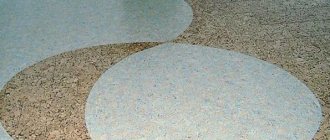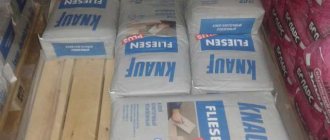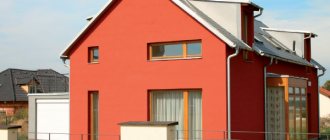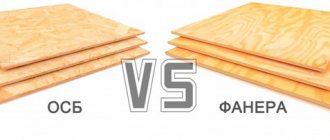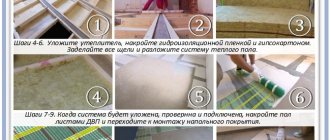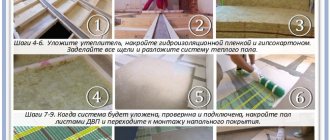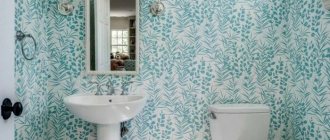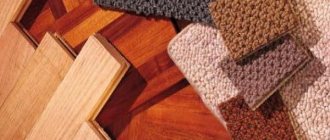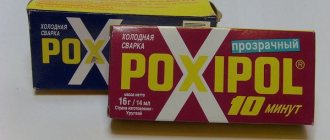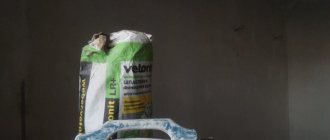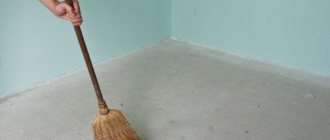Technical cork for insulating and soundproofing the premises of a house or apartment belongs to the category of the most effective natural materials, absolutely harmless to humans and the environment. This insulation is otherwise called cork agglomerate, and it is produced in two versions - in sheets or slabs of various thicknesses and in sheets rolled into rolls.
Technical plug for insulation
Due to its many positive characteristics, cork flooring is quite popular, despite its rather high cost. This publication is devoted to the advantages and disadvantages of such material.
Cork production and its structure
Cork insulation is based on the bark of the cork oak (Quércus súber), which is distributed only in a few countries: Tunisia, Morocco, Algeria, Italy, Spain, France and Portugal. Half of the total volume of this raw material is generated by plantations in Portugal, where this industry is of national importance. All countries producing natural cork export about 170 thousand tons of this rather rare material per year, which, in conditions of high demand, keeps its prices at a consistently high level.
Cork oak bark was used as insulation back in the Middle Ages by Spanish monks, who used it to decorate the floors of their cells. Mass industrial production of pressed cork chips (agglomerate) dates back to 1891, when this method was officially patented in the USA. The largest supplier of this material is the Amorim Group, all of whose branches are located in Portugal. The company began its path to success back in 1870; at the moment, more than 40 large industrial productions are united under this brand.
The microstructure of cork bark is a series of hard capsules connected in series, having the shape of an irregular polyhedron. The closest analogue of such a structure would be a honeycomb. Each capsule has a complex structure consisting of several layers:
- On the outside, it is covered with two layers of fiber, giving it structure.
- This is followed by a hollow chamber filled with a gas mixture close to atmospheric air (the only difference is the significantly reduced carbon dioxide content).
- Next is a drop of tree resin - suberin, which makes up the majority of all cork material.
- The core of the capsule also consists of celluloses, which gives it internal rigidity.
There are about 40 million of these capsules per 1 cm3 of cork raw material, which creates a unique membrane structure that has virtually no disadvantages. Internal cavities significantly reduce the thermal conductivity of this material, which makes it a high-quality insulation. At the same time, the high concentration of resin almost completely prevents the absorption of moisture, which is the main factor influencing the destruction of most thermal insulators.
In percentage terms, the composition of the cork looks like this:
- Suberin - 60%.
- Cellulose - 20%.
- Lignin, which binds rigid cellulose structures - 12%.
- Water - 5%
- Other impurities (tannins, cyrin, etc.) - 3%.
Raw cork raw materials have the following technical characteristics:
- Thermal conductivity - 0.04 ± 0.1 W/m*K.
- Water absorption percentage ≤13% of total mass.
- Density - 245 ± 5 kg/m3.
- The maximum withstand pressure is 1 t/cm2.
- Hardening at low temperatures, which quickly disappears when exposed to heat.
Moreover, all types of cork insulation have high levels of sound insulation and fire safety. Excellent sound absorption allows this material to be used as a separate means for creating special acoustic conditions. Also, the cork does not support combustion even when exposed to an open flame.
DIY accessory
A cork board made of material used for interior decoration can be made from a sheet of brown, white or black agglomerate. In offices, such a product serves as a stand for information sheets, and in homes, children’s drawings and photographs, various kinds of reminders, calendars, etc. can be placed on it. A cork board can be a great place to store keys. In the kitchen, it can display recipe records as well as information for family members. In the office, such a board is perfect as an accessory for storing office supplies. In a children's room it will be a wonderful stand for your child's drawings.
You can cut such a board yourself. The accessory, as a rule, has dimensions of 100x70 cm. It is cut out of sheet cork material and decorated around the perimeter with anodized aluminum. Information is attached to this board using regular push pins.
Varieties of heat-insulating materials based on natural cork
Natural cork raw materials can act as a heat insulator. But at an extremely high cost, it is more advisable to use special materials based on it, which include expansite (black agglomerate) and impregnated plates (white agglomerate). Cork bark is best used as a decorative finish for floors and walls. Its thin layer will not provide complete thermal insulation, but its original appearance can decorate any interior.
Both of these materials are produced on the basis of cork raw materials crushed into granules. The technology for producing black agglomerate involves heating to 300°C, which triggers the process of sublimation of suberin and, as a result, produces a homogeneous mass. By increasing the volume of internal cavities, the initial volume can increase up to 30%, which has a positive effect on the thermal conductivity and cost of the material.
The international format for this material is 1000 by 500 mm slabs. But depending on the brand, its thickness can vary from 10 to 300 mm. Thin sheets up to 50 mm are rolled into rolls, while thicker ones are supplied in the form of ready-to-use slabs. Due to swelling, the density of the expansite decreases to 120 ± 10 kg/m3, but the thermal conductivity remains at the same level - 0.04 W/m*K. This type of thermal insulation can be used at temperatures ranging from −200 to +150 °C, which allows it to be used even for insulating unheated floors and walls.
The technology for producing white agglomerate is much simpler: cork granules are pressed with the addition of natural adhesives. The standard format is slabs 900 by 600 and 1000 by 500 mm. If the sheet thickness does not exceed 50 mm, impregnated plates are also rolled into rolls. Density ranges from 110 to 260 kg/m3, average thermal conductivity is 0.05 W/m*K.
General information
Cork has been used as insulation for quite a long time, since its high thermal insulation properties are due not to special processing of natural raw materials, but to the internal structure of the substance itself.
What are natural cork panels?
Section of cork oak bark under a microscope
- Cork is a natural material that is extracted exclusively from the bark of the cork oak tree. The distribution area of this plant species is quite narrow, which is why this heat insulator costs a lot.
- Inside, the substance is a series of sealed chambers of microscopic size. Inside the chambers there is a mixture of gases, the main component of which is inert nitrogen.
- Thanks to this structure, even a fairly thin balsa wood plate has high heat transfer resistance; in addition, it is characterized by significant elasticity. So even with prolonged compressive deformation, after the load is reduced, the shape of the panel is restored quite quickly.
Depending on the raw materials used, several types of panels are distinguished:
- Natural cork is practically not used for thermal insulation; it is exclusively a decorative material.
- Cork agglomerate is a panel based on crushed cork, joined into a single array using adhesives and polymer materials. The most common thermal insulator.
Photo of an agglomerate panel
Cork granules are a loose insulation material that is used to fill cavities in the walls of frame houses, as well as underground spaces.
Thermal insulation materials based on granules made from cork tree bark have the following advantages:
- Low thermal conductivity - if used correctly, they significantly reduce the level of heat loss in the building.
- High elasticity and resistance to deformation. For this reason, cork is used not only as a thermal insulator, but also as a substrate for some types of floor coverings.
- Good noise absorption performance. Insulating walls with cork from the inside will provide your apartment with a decent level of sound insulation. In addition, agglomerate panels can be used to insulate the inside of a roof made of “noisy” materials, such as corrugated sheets or metal tiles.
Resistance to deformation and noise absorption makes cork agglomerate an excellent material for substrates
Environmental friendliness is another undoubted argument in favor of choosing cork. Among all insulators, it contains the least amount of potentially toxic impurities.
Fairly simple DIY installation can also be considered an advantage. Plates and rolls of agglomerate are easy to cut and mounted on almost any surface.
There are only a few disadvantages of this heat-saving substance:
- Firstly, the price is quite high. In terms of cost/energy saving ratio, agglomerate is clearly inferior to modern polymer insulation and mineral wool.
- Secondly, insufficient moisture resistance. When moisture enters, the granules begin to swell and deform, which is why in most cases additional hydro- or vapor barrier is required.
Specifications
The characteristics of insulation depend not only on the properties of the material, but also on the form of its manufacture. Therefore, if we talk about this material as a whole, we can outline its average characteristics:
- the density of the material is 110-130 kg/cm3;
- specific gravity 200 kg/m3;
- thermal conductivity 0.04 ± 0.1 W/m*K;
- vapor permeability 0.2 mg/m*hour*Pa
- fire resistance class M3.
It is important to know that manufacturers of cork insulation claim that it is not subject to aging . Therefore, it will serve as long as the building itself lasts.
Caring for applied insulation
No special care required. It is enough to periodically wipe the dust with a dry cloth or varnish and wash. For processing, use only polyurethane and acrylic-based varnishes.
If gaps appear between the sheets, they must be properly sealed. First, a piece of cork is glued inside, the edges and edges of the piece are coated with glue. It is recommended to paint the outside with a protective agent immediately after drying.
It better protects the coating from the effects of oil-wax, which you can purchase and apply yourself.
Varieties
The cork is produced in the form:
- agglomerate – white and black;
- roll material;
- dense slabs.
White agglomerate
This type of insulation is used for interior work and does not require finishing; it is obtained from the bark of tree branches. Under the influence of high temperature, the crushed material is pressed using glue. The plates have:
- fire resistance class M3;
- high density up to 130 kg/m3;
- minimum percentage of humidity;
- and high sound absorption coefficient.
Due to its light weight and thickness, white agglomerate is suitable for internal insulation, interior decoration and as a soundproofing material.
Black agglomerate
Black cork insulation is used for interior work; it is produced in the form of slabs. It consists of compressed granules. They are heated and partially charred, which gives the material a dark color.
Black agglomerate is intended for insulation of roofs, walls, suspended ceilings, floors, and also as a soundproofing material. The panels do not absorb moisture, they are resistant to the formation of harmful bacteria and mold. Material properties:
- density from 95 to 130 kg/m3;
- thermal conductivity -0.040 W/μ;
- low vapor permeability;
Roll version
It comes in different grain sizes and thicknesses. On average, the length of the roll is 25 square meters. m., it is used as a substrate for parquet, laminate and as insulation for walls.
Rolled cork is not used for heated floors. The material has high thermal insulation properties and therefore the heat from the source will warm the ceiling, and not the floor and air in the room.
Tile
This is a thicker type of material, used for external and internal work when installing roofs, for insulating foundations and external walls. Used for country houses and high-rise buildings.
Tiles can be single-layer or consist of two layers. The latter option is available painted, tinted or varnished. Two-layer tiles do not require finishing and can be used in the interior of an apartment or house.
Thermal insulation of concrete - features
The peculiarity of concrete walls is that in order to insulate them, everything needs to be calculated and planned in advance. The task is not easy when compared with walls made of brick or wood, but it is doable. Insulation of a concrete wall outside and inside has the following features:
- The surface must be treated with antiseptic agents.
- Communications and wiring are laid even before thermal insulation work.
- When insulating a façade, the entire area is treated; you cannot do only certain areas or a wall.
- Areas behind heating radiators are treated using insulation with foil. This is a thin aluminum layer on insulation. It will reflect thermal energy.
If we talk about internal insulation, there are also some nuances here. For example, condensation will accumulate inside, since the moisture has nowhere to go
Therefore, it is important to ensure good ventilation. In addition, environmentally friendly insulation is selected, which will not harm health
Myth 1 - Insulating a wall from the inside with cork is expensive
You can buy cork panels at a price of 650 - 700 rubles. for 1 sq. m. But when using them, you can immediately find a solution to the problem of how to insulate the wall from the inside, as well as make the wall aesthetic. But let's look at alternative options:
1. Use of thermal insulators and conventional finishing.
Penoplex and other synthetic heat insulators and, for example, wallpaper.
Firstly, cork is completely natural, but these materials are not. Secondly, additional thermal insulation materials take up space - at least 3-6 cm from each wall. Thirdly, in terms of money, such insulation of the wall from the inside will be more expensive, taking into account the cost of the heat insulator and special structures, wallpaper, installation work (if specialists install it).
2. Decorative paint or plaster.
It will not solve the problems of thermal insulation, freezing and cold walls, it will require preparation and leveling of the walls, so the final cost per 1 sq. m may be even higher than for cork panels, especially if the work is carried out by specialists.
3. Wallpaper - cheap, if it falls off from the freezing wall, you can re-glue it.
First of all, not all wallpaper is cheap. Secondly, it is under them that mold often grows on freezing walls. Thirdly, wallpaper usually has to be changed after 5-6 years. But wall plug is an eternal material. Thanks to the protective wax coating, the panels are easy to clean; any stains can be removed with an eraser or detergent without abrasives. Cork wall coverings do not fall off thanks to special contact adhesive, do not lose their external characteristics, and last for more than 15-20 years.
Nuances of internal installation
Foam plastic is most often used for internal wall insulation in brick houses. Before installation work begins, any finishing is removed. The surface is thoroughly plastered and then treated with a primer.
It is very important to apply the primer evenly so that cracks do not begin to form after drying.
The insulation sheets are installed on the still damp material. The insulation material is attached using construction adhesive.
It is very important to pay attention to the components of the composition. The adhesive material should not emit toxic fumes
Insulation from the outside
For exterior work, mineral wool is most often used. The start of work follows a similar algorithm. On the outside, the panels are protected with an additional layer of primer to resist weathering, and a decorative finish is applied over the protective layer.
The corner apartment of a brick house is insulated from the outside
A brief overview of foam brands for insulating walls from the inside
In building materials stores you can see a fairly large assortment of foam brands. Let's look at the most common of them. Regardless of the brand, there can be two types of marks on the box: “PS” and “PSB”. The first indicates that the material was made using the pressing method, the second - the non-press method.
A popular brand of polystyrene foam is C-15. This type is produced using a non-press method. Due to its high density, it is excellent for both indoor and outdoor use. However, foam plastic of the S-25 PSB brand is best suited for insulating corner apartments. This is a higher density material that can also be used for floor insulation. The S-35 PSB grade is characterized by excellent resistance to extreme weather conditions. It is characterized by high fire resistance, as well as the ability to easily withstand mechanical damage. The densest variety is the S-50 PSB. This is a fairly expensive material, which is usually used in cases of frequent hail and constant strong wind.
For internal insulation, only the first two options are used.
A brief overview of mineral wool brands for insulating walls from the inside
There are four most popular varieties of mineral wool: P-75, P-125, PPZh-200 and PZh-175. For interior work, only the first two varieties are used. Cotton wool P-75 is the lightest and has a relatively low density. P-125 is more rigid and is used for interior decoration in cold climates. The last two types, due to their increased density, are used only for outdoor work.
Myth 3 - Cork is not a practical material
You can even include a few misconceptions here:
- Does it absorb odors? No, it's covered with wax.
- It can be easily damaged - children will throw something, a champagne cork will fly off. You can damage a cork panel only on purpose, by taking a nail, for example. Normal use is not scary for her.
- Can't be washed. Can! Wash, wipe, use non-aggressive detergents. The plug is not afraid of water, flooding, or condensation.
- Difficult to glue. Easy, even easier than wallpaper, because the 600x300 mm format is much more convenient than stripes the entire height of the wall.
Warm, comfortable, elegant, environmentally friendly cork panels are an ideal option for the home.
Cork 3D panels
Are you still thinking? Then the last argument. Invest in a wall plug and forget about renovations for years to come. Wall panels will serve not only to insulate the walls from the inside, but also for beauty. Choose a shade and texture that you like, let the walls be the backdrop for other details with which you can update the interior in the future. Cork panels are a repair once and almost forever, no re-gluing every 5 years. Wet cleaning and they are as good as new. Now it’s worth taking a look at the range.
Additional ways to keep your home warm
There are several other options to keep the room warm. Experts recommend doing the following:
- If the apartment is located on the south side, then on a sunny day try to open the curtains as much as possible. Even the seemingly cold winter sun provides a sufficient level of heat through the prism of the glass.
- You can additionally stick a thermal protective film on the windows. It does not reduce visibility. But it retains heat well in the room.
Windows with Film
If you have a fireplace or stove in your home that you are not using, be sure to block the chimney. 30% of the heat escapes through it.
But do not forget to open the chimney when using the fireplace. Otherwise, carbon monoxide will go into the room.
If it is possible to install heating in the house in addition to centralized heating, use oil radiators or ceramic panels. They are the safest and provide a large percentage of heat. If possible, abandon central heating in favor of individual heating. This way you can control the temperature in your home yourself.
And of course, just dress warmly in winter. Warm socks, knitted by the hands of a caring grandmother, will give not only warmth, but also spiritual comfort.
Having figured out how to insulate an apartment from the inside with your own hands without repairs, do everything necessary to preserve heat. And in the spring and summer, if possible, do major work on replacing windows, doors and insulating the floor.
Using cork insulation
Cork insulation is made in various forms: rolls, slabs or even in the form of a laminate, which is used as a finishing floor covering. Before installation, the cork material is acclimatized at room conditions.
They cover and protect walls, roofs, floors and even foundations from heat loss with cork.
For wall insulation
Rolled materials and tiles are used here as insulating cork material. They can be glued under wallpaper. Roll and tile material is available in thicknesses from 2 to 10 mm. You can use any material for walls; the greater the thickness, the better the heat in the room is retained.
Insulation and finishing of the balcony with cork
The general method of insulating walls is as follows.
- The surface of the walls is cleaned. Wallpaper is removed because the glue can cause it to soften and fall off.
- Defective parts and irregularities are leveled and primed.
- After the primed surface has dried, installation of insulation on the walls begins.
- Roll insulation is pasted on like wallpaper. For better adhesion, coat both the walls and the surface of the insulation. Wait a couple of minutes until the material dries slightly, only then apply it to the surface of the wall.
- To glue insulation in the form of slabs, markings are first made. The walls are divided into two equal parts and lines are drawn horizontally and vertically. The first tile is glued in the middle of the wall, and the subsequent ones are either perpendicular to the floor surface or parallel to it.
For better gluing of the agglomerate, special glue, contact or acrylic-based, is used. Universal acrylic adhesive is used for installing insulation on walls, and contact adhesive is used for floors. The difference between these compositions is that acrylic is applied to one of the surfaces, and contact is applied to both.
For floor insulation
Cork agglomerate is also suitable for insulating floors in the house. Rolled cork acts as a substrate for the finishing floor covering (laminate, parquet, linoleum), because it allows you to distribute the load over the entire sheet.
Floor insulation with cork material
Important! For laminate and parquet, cork insulation cannot be used as a substrate with a thickness of more than 2-3 mm. This is explained by the fact that the greatest difference in base heights for these coatings is 2-3 mm per square meter. With large thicknesses, strong deformations of individual sections of the base are formed over time, which leads to breakage of the locking joints.
Before installation, the floor is cleaned of dirt. If the old coating is durable, you can leave it. On a dry, prepared surface, markings are made from the central point of the room perpendicular to the walls.
Tiled insulation is laid perpendicular to the entrance from the center of the room. In this case, an adhesive composition is used to connect the slabs to the surface.
The rolled material is cut into pieces of the required size with a margin and laid away from one of the walls. There is no need to use glue to fix the strips to the surface. The rolls are secured together with tape, after which the finished floor is laid on them.
Insulation with cork and expansite is expensive, but thanks to the heat-insulating properties, it is possible to create a good heat-protective contour of the room with a small thickness of the material. In addition, this material is also used as a finishing material, which makes it possible to save money.
Stage 3 additional protection of cork panels after installation
Cork wall panels for interior decoration do not always require the application of a protective compound after installation. Still, when working in a room with high humidity, it is better to treat the front surface of the finishing material with moisture-resistant varnish. It should be noted that some versions of cork wall panels initially have a protective layer - in this case, independent processing will not be necessary
Cork is a beautiful and noble material for wall cladding
Cork is a material with amazing properties.
This is a universal and, not least important, natural finishing material, which is widely used not only for finishing floors, but also for creating wall surfaces. Cork panels will make the interior cozy and truly warm
Cork is distinguished not only by its varied texture, but also by other significant advantages, about which the story will go further...
What are cork wall panels for interior decoration made from? It's simple - they are made from cork granules, and the slabs, in turn, can have one or, accordingly, two layers. The process of manufacturing panels is simple - cork granules are placed in a pressing machine and then, using the required machine settings, cork panels of the desired configurations and microtextures are created.
It should be noted that any cork panel must be coated with ceresin or wax. In addition, any cork panel also has a backing layer - its thickness can range from two to three millimeters. Sometimes, in the production of cork panels, a so-called press blank is used - it is used when it is necessary to produce wall panels from cork for two-layer interior decoration. In the latter case, the glue is applied directly to the workpiece, and then a layer of veneer-cork is fixed on top and at the very end the veneer surface is covered with a layer of wax.
What are the advantages of cork panels? There are a lot of them, but they are not obvious at first glance.
Special adhesive for installing cork panels on the wall
Advantages of cork wall panels:
- High level of elasticity
- The surface itself recovers after impacts and other mechanical impacts.
- High level of elasticity
- Little weight
- Protects against electromagnetic radiation
- High level of wear resistance
- No absorption of dirt or odors
- Protection from moisture and gases
- Fire safety
- Durability
- Easy installation
- Just care
- There is no possibility of fungus appearing
- No possibility of mold growth
- Environmental friendliness
- Does not cause allergies in humans and animals
Thus, we can say for sure that cork wall panels for interior decoration have a lot of strong advantages - which is why this facing material is in justifiable demand. However, this material also has weaknesses.
Cork is very popular when cladding walls not only in private houses, but also in apartments
Disadvantages of cork wall panels:
- Installation must be done without errors on the first try
- After serious deformation, the original texture and shape will not return immediately
- High price of material
- In all areas where pressure was applied to the plug, characteristic indentations will remain.
- Fast fading under constant exposure to direct sunlight
Cork insulation technology
Installation of plugs for thermal insulation of walls and floors is carried out taking into account the characteristics of the material:
- Rolled products must be unrolled before laying so that the web can rest and straighten in the appropriate temperature environment. Otherwise, installation difficulties will arise, since when rolled up the cork takes on a characteristic shape;
- It is easier to work with sheet cork than with the rolled version. However, you will have to follow the technology of fitting individual fragments, which is especially difficult in corner areas.
When choosing an adhesive for laying cork, take into account that different compositions provide different adhesion abilities. The properties of fixing substances determine such aspects as the speed of installation work and the permissible time frame for the start of operation of the facility.
Tools and materials
When laying cork to insulate walls inside an apartment, the following set of tools and materials is required:
- sander;
- jigsaw, sharp knife;
- primer;
- tape measure, marker;
- laser level or painting cord;
- glue, spatula;
- sealant;
- water-based varnish, roller or brush.
To insulate with cork, you will need a grinder.
You also need to prepare the required amount of cork insulation of the desired brand.
Necessary calculations
When planning to insulate walls with cork from inside the apartment, calculations should be made based on the area and features of the surface being equipped. It is also important to make markings to ensure the correct lines for laying the insulation coating:
- on the wall, a perfectly straight vertical line is struck from the corner using a laser tool or painting cord;
- stepping back from the upper boundary of the wall under the ceiling, determine the horizontal.
If thermal insulation from tiled cork is planned, horizontal lines are marked across the entire area of the wall, since the coating is laid from the lower perimeter. Installation of roll sheets is carried out similarly to gluing wallpaper.
Insulation and finishing of walls and ceilings
Cork insulation is installed end-to-end. Roll sheets prepared along the length are glued starting from the vertical line. The sheet insulator is laid from the bottom of the wall. Moreover, horizontal lines determine the location of the rows of tile cork. Ceiling insulation is carried out according to a similar scheme.
The adhesive is applied according to the manufacturer's instructions, on both surfaces or only on one - on the tiles or the base being installed. The gaps are filled with a special sealant for cork coverings. After complete drying, finishing work is performed. Most often, cork on the wall and ceiling is treated with a colorless water-based varnish.
Despite the high cost of the material, cork insulation is in demand due to its high performance and decorative characteristics. The service life of insulation is commensurate with the resource of the structure itself, which makes cork relevant for insulating the walls of apartments and country houses.
Soundproofing the floor
Experts advise creating a multi-layer structure. Various technologies are used to soundproof floors, but the most common is the floating option. First you need to replace the surface, and then purchase building materials. After this, you can consider the step-by-step installation algorithm:
The floor is leveled and defects are removed. The boards are laid, which are fastened with self-tapping screws towards each other.
It is important to maintain the slope and fasten the structure at an angle of 55-65 degrees. The soundproofing substrate is being laid. It is necessary to lay a waterproofing film underneath. The finishing layer is applied
If slabs are purchased, they need to be fastened groove to groove. It is important to leave small gaps near the walls.
The installation is performed in a staggered manner to avoid overlapping joints. Only after all the slabs have been laid, the baseboards are installed. Any floor, and cork in particular, must be left in place for ten days.
Main advantages of the material
The excellent thermal insulation qualities and environmental safety of cork insulation are complemented by the following positive qualities :
- strength and light weight;
- does not change volume when humidity changes;
- does not ignite;
- when exposed to moisture, mold does not form on the material;
- does not rot;
- not destroyed by rodents;
- simple installation;
- has dielectric properties and does not accumulate static electricity.
Ceiling covering
Soundproofing the ceiling is done to reduce sounds from neighbors above. A common practice is to install a suspended ceiling, inside which an insulating layer is inserted or sprayed. But a significant drawback of the method is a partial reduction in space.
A thin cork alone will not prevent the appearance of sounds; this can only be achieved by combining sound insulation.
The multi-layer cladding design creates a good level of noise protection. The plates used for work must be at least 3 cm thick.
The principle of operation of ceiling soundproofing
Insulation is carried out only on a leveled ceiling without gypsum putty, so that there is a high level of adhesion. Then, the surface is degreased and coated with a cement-based primer or an aqueous adhesive solution.
The ceiling is divided into 4 sections, and the central point is determined. By applying and drawing the image of one tile, marking, application of glue, and installation of raw materials are carried out. The adhesive mixture is also applied to the back side of the tile to make it more secure.
Disadvantages of cork insulation
There are practically no significant disadvantages to this type of insulation. Only a few weaknesses of the material are noted:
- The insulating substrate of the wall may be damaged if this type of finish is used at industrial facilities and provided that metal cutting or other types of processing of this material will be carried out in the room. The fact is that metal shavings contribute to the deterioration of the thermal insulation qualities of the cork. Solid particles clog the pores of the insulation. Prolonged use in such conditions will lead to damage to the structure of the cork coating.
- Insulation, characterized by low density (95-130 kg/m³), allows vibration waves to pass through. This means that it cannot be used as a barrier to prevent vibration noise from penetrating into the object. To protect against vibrations, it is better to consider cork insulation with a density of 130 kg/m³ or more.
- High price. Considering the excellent insulation properties of cork, as well as the absence of synthetic additives in the composition, one would expect that such insulation would be offered at a high price. However, one must take into account the long service life of the cork, which allows the use of such a finish without the need for periodic replacement.
The material protects against noise if the main condition is met - the high frequency range is provided (1.5 kHz).
Dew point: physics of the phenomenon
The ratio of humidity and temperature at which steam turns into droplets is called the dew point. Under natural conditions, this is how fog, dew, frost and clouds are formed.
If the water vapor is at the dew point, it is called saturated. The amount of steam at which it becomes saturated depends on the temperature: the colder it is, the less steam is required. To indicate how close steam is to the dew point for a given temperature, relative humidity is used, which is expressed as a percentage. 100% is saturated vapor that is ready to fall out as mist or dew.
In construction, the dew point is not a point on a temperature scale, but rather the area where water vapor can become saturated. This point should always be outside the wall on the street side. To achieve this effect in winter, you need to carefully calculate the vapor permeability and thermal conductivity of surfaces. In any weather, the outer wall of the building must be warmer than the surrounding air so that the steam evaporates from its surface and has time to dissipate before it falls in the form of frost. It should be taken into account that in cold weather the dew point approaches the wall, and in warm weather it moves away.
If the temperature difference between the wall and the air outside is insufficient, the dew point moves closer to the wall or inside it. Moisture condenses on the surface or between layers of material where cold and warm air come into contact. This leads to negative consequences, which include:
- In the destruction of materials;
- Freezing of the wall in frost;
- The appearance of mold and mildew.
Soundproofing walls with cork in an apartment, how it’s done
To ensure effective sound absorption, it is recommended to use several types of soundproofing coatings, characterized by different structures. Among them may be cork material. It is recommended to install it on the inside of the room where the noise source is located. If technical covering made of balsa wood is installed, it should be mounted on a rough base. Decorative material is laid last, as it is used as a finishing touch. Cork can be laid on walls in several layers.
Is it possible to insulate from the outside?
Cork coating is also used for facades, as it has the following advantages:
- helps conserve heat;
- reduces noise levels;
- does not collapse under the influence of temperature changes and precipitation;
- has a service life of about 25 years.
To finish the facades, liquid cork is used, which is applied to the surface in several layers using a sprayer. The material has a wide color palette and is not demanding in maintenance.
Criterias of choice
When choosing a plug for insulating an apartment, take into account the following points:
- application features. Depending on the planned work, choose cork in rolls or in the form of sheet material;
- cork thickness parameters. Priority is given to material of maximum thickness if a heat and sound insulation system of a high level of reliability is required;
- manufacturer. Portugal is considered the recognized market leader in the production and sale of cork; well-known brands from Mediterranean countries also offer these products;
- price. White agglomerate is relatively cheaper than black. The cost of a rolled cork starts from 135 RUR/m², depending on the thickness. Sheet insulation is sold at an average price of 600 rubles/m².
When visually inspecting a material, such characteristics as surface smoothness, uniformity of structure, and elasticity require attention. It is worth considering that high-quality cork insulation does not crumble, and it is also not easy to break off a piece of the product.
Treating windows for colds
Windows in Ekaterinburg apartments have been actively converted into plastic for more than 10 years. Nevertheless, as repairmen note, 50-60% of city residents' apartments still look at the world through glass framed in wood. Wooden windows are very good from an environmental point of view, but over time their thermal insulation properties may deteriorate. Director Timur Abdullaev notes that today the old-fashioned method of “piercing” wooden windows with ordinary cotton wool has not lost its relevance. Especially if the apartment owner is concerned about insulating the home after winter has arrived. When it’s frosty outside, it’s more difficult to properly repair wooden windows.
Timur Abdullaev Director Repair of a wooden window begins with the search for cold bridges - gaps and cracks. We clean the places where they are found from dirt, and if necessary, use a spatula to remove the paint that has covered the cracks. After this, we fill the cracks and gaps with transparent sealant. It is sold in the form of “pencils”. It is better to do this work before the cold weather.
The problems may not be in the window itself, but in the places where it adjoins the walls. As master Alexey Zykov notes, according to construction GOSTs, a whole range of special materials and technologies must be used when installing a window. In practice, many elements are forgotten.
The best manufacturers of cork insulation
The main suppliers of cork agglomerate to our country are Portuguese manufacturers. Among the leading companies in the insulation materials market are the following brands:
- Amorim, the oldest manufacturer leading the global market . The average cost of materials is presented in the range - for panels from 600 rubles / sq. meter, the cost of packaging roll material starts from 1200 rubles.
- Wicanders, the company's product range includes cork insulation for wallpaper and decorative cork coverings. The cost of insulation starts from 1,300 rubles per roll.
- Izora specializes in the production of panels designed to insulate walls, roofs and floors. The average price, depending on the type of agglomerate, is 600-450 rubles/sq.m. meter.
- Sedacor. The main products are cork insulation in rolls and sheets. Packaging sheet insulation (6 square meters) will cost the buyer approximately 900 rubles, and the cost of roll insulation starts from 135 rubles. per sq. meter.
Many potential buyers of cork insulation are confused by the high cost of this material. In fact, this is its main disadvantage . The cost of building a house that is insulated with cork agglomerate can increase by 8-10% compared to using synthetic insulation.
It is not recommended for use in rooms where high humidity is constantly present, since even after treating the insulation with compounds that improve its moisture resistance, it remains sensitive to moisture. Moreover, it has the ability to accumulate it.
To install the cork covering, you need to purchase a special glue . Its cost is high, which significantly increases the cost of insulating a house.
However, if you take into account the quality of balsa wood insulation, its unlimited service life and the absence of harm to the health of its owners, the cost turns out to be not so high. Therefore, many consumers who care not only about maintaining heat, but also about the health of their family, are increasingly using cork insulation in the construction of their homes.
All about cork agglomerate - the best insulation for the home, watch the video:
Scope of application of black agglomerate
Cork has been used as insulation since ancient times. Agglomerate appeared only in 1892, and before that, insulation was carried out by alternately gluing thin solid plates.
External insulation using this material is carried out using the wet or dry method, depending on the type of walls. Thus, walls made of masonry materials are first plastered for leveling purposes, after which slabs are glued to them with a special compound. It is not necessary to use disc dowels. After the glue has dried, a finishing coat is applied to the cork.
Frame houses are insulated in the traditional way by placing agglomerate slabs between wall sheathings. But, since cork has very low water absorption, walls insulated with agglomerate are not vapor-insulated from the inside and, accordingly, remain vapor-permeable(!).
Walls made of timber are insulated with cork from the outside. The slabs of agglomerate are fastened with nails to the timber, after which wooden lining, siding, block house, etc. are piled on top of them.
Cork has a great advantage when insulating wooden houses. It preserves the vapor permeability of solid wood walls, thereby providing a favorable indoor microclimate.
The low water absorption of black cork agglomerate makes it one of the few insulation materials suitable for insulating flat roofs, incl. and in use, as well as for floor insulation.
